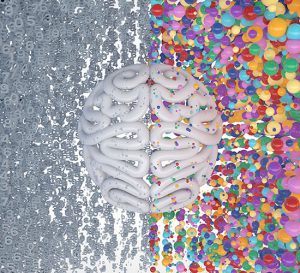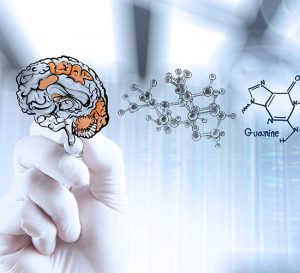Alzheimer’s dementia: The main brain regions affected
 The temporal lobe (lobus temporalis) is usually the first to be affected, which manifests as memory loss. The forebrain lobe (lobus frontalis) controls the motivation to, for example, get out of bed or actively participate in life. Lethargy and demotivation spread and isolate those affected from their environment. A clear sign of synapse disruption is the constant repetition of meaningless activities such as constantly folding laundry or putting shoes on and off.
The temporal lobe (lobus temporalis) is usually the first to be affected, which manifests as memory loss. The forebrain lobe (lobus frontalis) controls the motivation to, for example, get out of bed or actively participate in life. Lethargy and demotivation spread and isolate those affected from their environment. A clear sign of synapse disruption is the constant repetition of meaningless activities such as constantly folding laundry or putting shoes on and off.
The right parietal lobe (lobus parietalis) is responsible for face and object recognition. Those affected recognise the voice, but not the person who is speaking: “That is my son’s voice, but I don’t know you” is what they say, for example. If the left parietal lobe is affected, this manifests itself in difficulties with arithmetic, writing or distinguishing between left and right (Noh, Jeon et al. 2014).
The precuneus part of the brain sits in the middle between the two parietal lobes and shows early memory disorders as a mild cognitive deficit (MCD) even before the full-blown Alzheimer’s dementia can be detected. With the Montreal Cognitive Assessment (MoCA – test), this preliminary or transitional stage to dementia can be recorded and objectively depicted by magnetoencephalography (MEG) (Yokosawa, Kimura et al. 2020). Blood flow can be reduced early in the precuneus (Miners, Palmer et al. 2016), so it is thought that increasing blood flow can mitigate functional limitations.
Difference Transcranial Pulse Stimulation (TPS®) – Drug Therapy
Pharmaceutical research is trying to develop a therapeutic approach via the degradation of tau fibrils (altered proteins that accumulate as fibres and destroy the cells) and amyloid plaques (protein fragments that accumulate to form insoluble plaques). The administration of cholinesterase inhibitors may slow down the rate of progression of dementia somewhat.
Transcranial pulse stimulation with shock waves (TPS®) relies on reactivating the switching function of the synapses, which appears to be scientifically proven from a clinical point of view and through the reduction of the brain atrophy typical of Alzheimer’s disease (Matt, Kaindl et al. 2022).
The Physics of Transcranial Pulse Stimulation (TPS®)
Transcranial Pulse Stimulation (TPS®) uses so-called focused shock waves. These extremely short, low-frequency sound pulses are generated electromagnetically by the NEUROLITH® shock wave system.
These shock waves are generated every 200 to 250 ms (milliseconds) at a frequency of four to five Hz (hertz = unit for vibrations per second) and stimulate the brain tissue. In the process, the shock waves penetrate about eight centimetres into the brain, which absorbs about 70% of the energy that does not scatter. What is important here is that, unlike in other medical fields of application where shock waves are used for diagnostics and therapy, the energy in the TPS® is only 0.25 mJ/mm2 (millijoules per square millimetre). This prevents heating of the surrounding tissue and thus tissue damage.
TPS® treatment then reaches all relevant brain areas that are affected in Alzheimer’s dementia.
The biological effect of Transcranial Pulse Stimulation (TPS®) shock waves
TPS® works via so-called mechanotransduction and not via destruction as in the treatment of kidney stones. Mechanotransduction converts physical signals into molecular processes that are responsible for controlling cell function (e.g. proliferation, differentiation and migration). It is now scientifically proven that mechanical forces are sufficient to trigger both the outgrowth of a neural process and to initiate axonal growth and regeneration.
Precision medicine in the brain – with TPS® regeneration is possible for the first time.
The extremely short sound pulses of Transcranial Pulse Stimulation (TPS) could lead to short-term membrane changes in brain cells through mechanotransduction (Hatanaka, Ito et al. 2016). It is thought that this changes the neuro-biochemical environment, which could lead to the activation of nerve cells and the formation of new synapses. Similar to a part of the central nervous system – the spinal cord – new vessel formation (Yahata, Kanno et al. 2016) and nerve regeneration could occur. The treatment also supports the release of nitric oxide (Hatanaka, Ito et al. 2016) and the stimulation of so-called BDNF, proteins from the group of neurotrophins that protect nerve cells and synapses (Matsuda, Kanno et al. 2020). In animal experiments, the damaging effects of reduced blood flow could be compensated for by low-energy treatment of mouse brains (Chai, Chen et al. 2017).
In the meantime, studies have also shown that the shock waves lead to an upregulation of neuroplastic processes (neuroplasticity = describes the property of the brain to be changeable through training). In addition, there is a reduction in cortical atrophy, i.e. the loss of brain tissue (Matt, Kaindl et al. 2022).
Note: Apart from the previously published placebo-controlled study by Matt (Matt, Kaindl et al. 2022), further studies are ongoing in various university institutions.
The study and clinical results available so far are extremely promising. Furthermore, in daily practice with meanwhile more than 1,500 patients treated, positive results are shown in 80% of the patients treated, which have changed the lives of those affected and their relatives in a significantly positive way.
Literature – short notes:
Depression: (Matt, Dörl et al. 2022)
Mechanical transduction: (d’Agostino, Craig et al. 2015)
Permeabilization mammalian cells (López-Marín, Rivera et al. 2018)
NO Nitric oxyde (Ledo, Lourenço et al. 2021)
BDNF (Wang, Ning et al. 2017)
 In all body organs, there is a balance between pro-inflammatory and anti-inflammatory cytokines. Cytokines are peptides – molecules with less than 100 amino acids – or proteins – with more than 100 amino acids – that serve signal transmission, cell proliferation and their differentiation. In Alzheimer’s dementia (AD) and its precursor mild cognitive deficit (MCD), the anti-inflammatory effect of interleukin-33 (IL-33) was shown to be abolished (Saresella, Marventano et al. 2020). The concentration of the pro-inflammatory interleukin-6 (IL-6) was significantly increased, whereas that of the anti-inflammatory interleukin-10 (IL-10) was significantly decreased. This finding could lead to a future drug therapy with the substance IL-33, but the development cycles of new drugs are very long.
In all body organs, there is a balance between pro-inflammatory and anti-inflammatory cytokines. Cytokines are peptides – molecules with less than 100 amino acids – or proteins – with more than 100 amino acids – that serve signal transmission, cell proliferation and their differentiation. In Alzheimer’s dementia (AD) and its precursor mild cognitive deficit (MCD), the anti-inflammatory effect of interleukin-33 (IL-33) was shown to be abolished (Saresella, Marventano et al. 2020). The concentration of the pro-inflammatory interleukin-6 (IL-6) was significantly increased, whereas that of the anti-inflammatory interleukin-10 (IL-10) was significantly decreased. This finding could lead to a future drug therapy with the substance IL-33, but the development cycles of new drugs are very long. The temporal lobe (lobus temporalis) is usually the first to be affected, which manifests as memory loss. The forebrain lobe (lobus frontalis) controls the motivation to, for example, get out of bed or actively participate in life. Lethargy and demotivation spread and isolate those affected from their environment. A clear sign of synapse disruption is the constant repetition of meaningless activities such as constantly folding laundry or putting shoes on and off.
The temporal lobe (lobus temporalis) is usually the first to be affected, which manifests as memory loss. The forebrain lobe (lobus frontalis) controls the motivation to, for example, get out of bed or actively participate in life. Lethargy and demotivation spread and isolate those affected from their environment. A clear sign of synapse disruption is the constant repetition of meaningless activities such as constantly folding laundry or putting shoes on and off.

